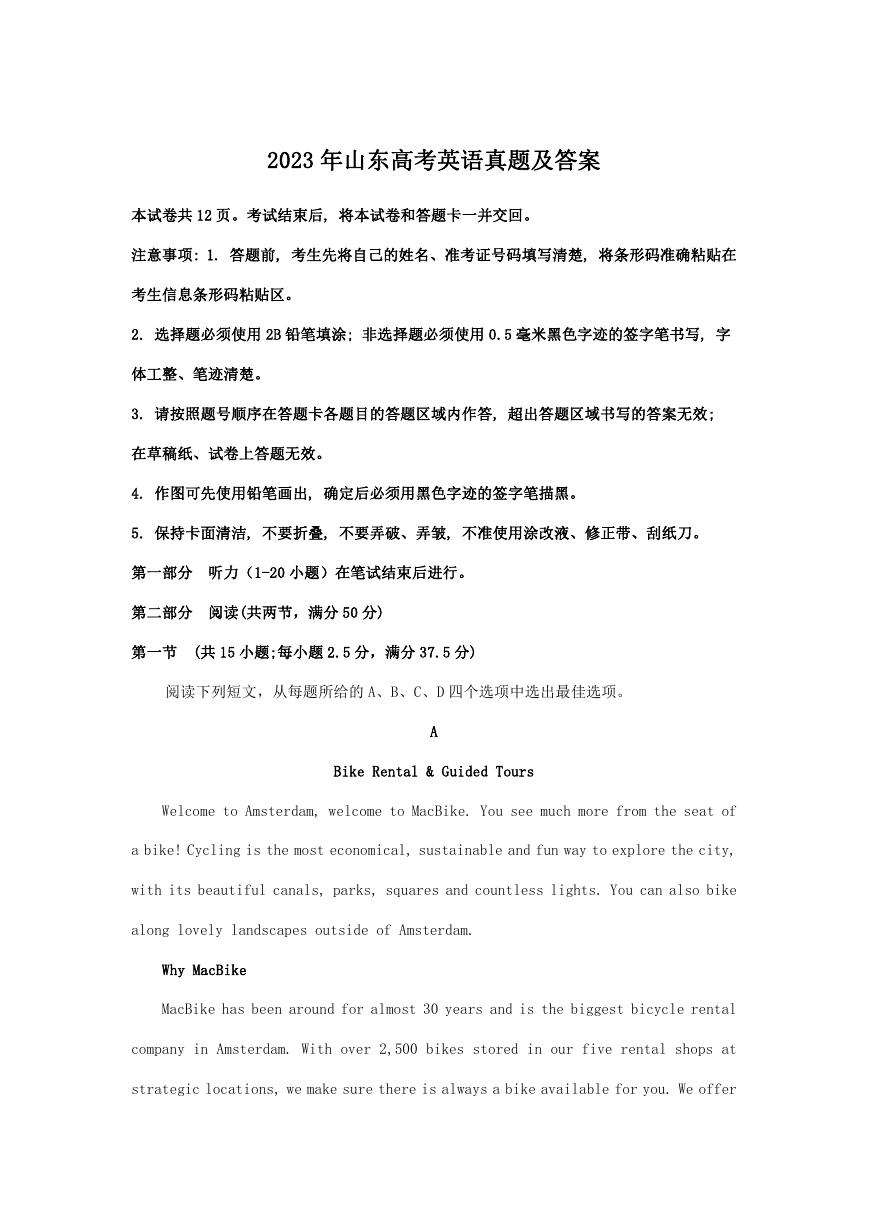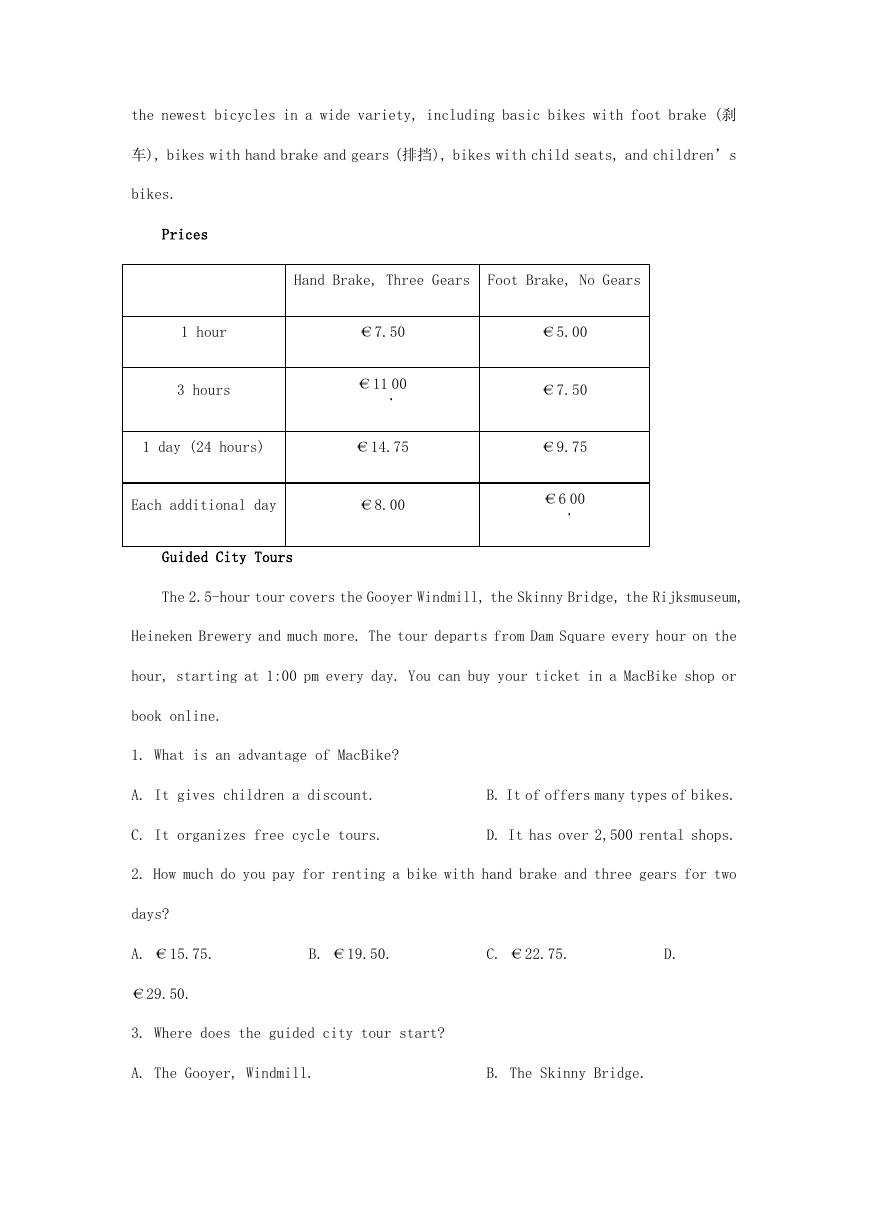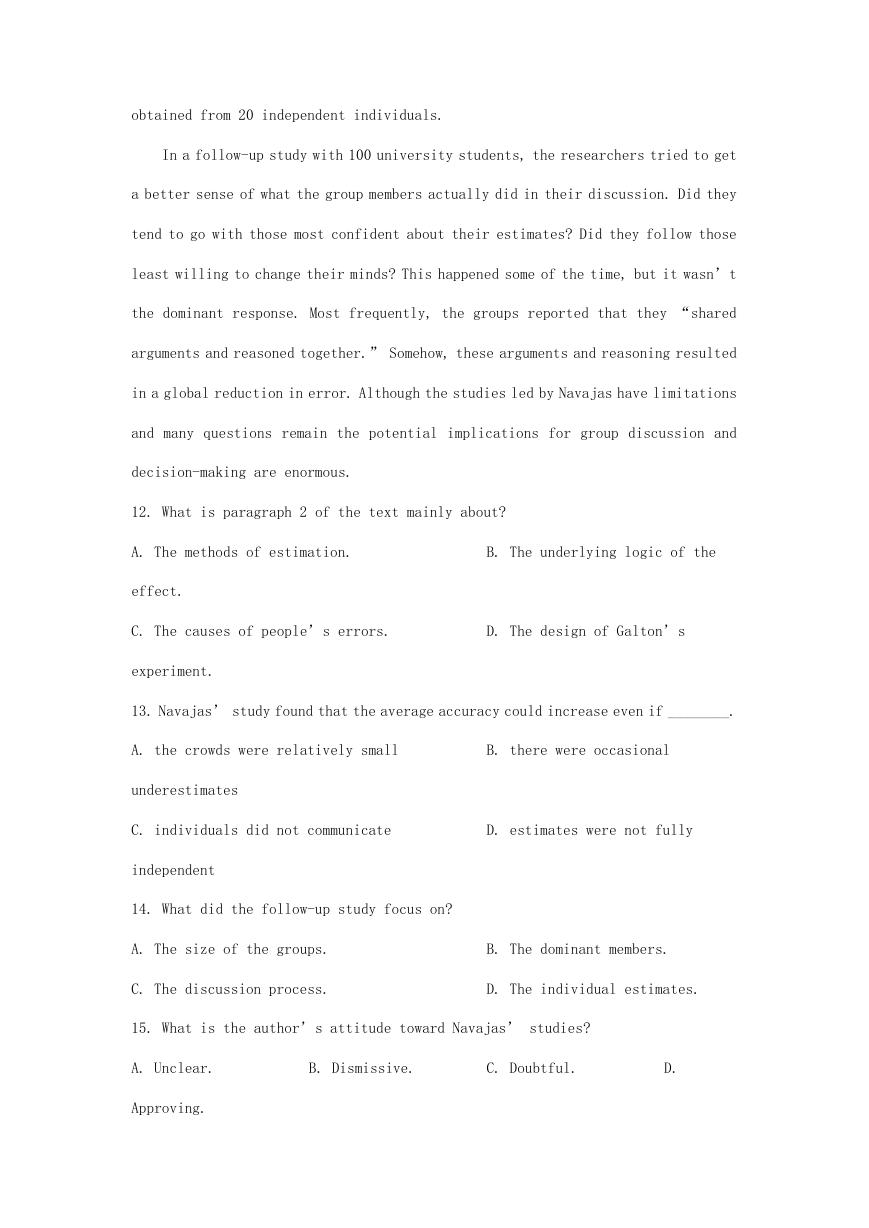2023 年山东高考英语真题及答案
本试卷共 12 页。考试结束后, 将本试卷和答题卡一并交回。
注意事项: 1. 答题前, 考生先将自己的姓名、准考证号码填写清楚, 将条形码准确粘贴在
考生信息条形码粘贴区。
2. 选择题必须使用 2B 铅笔填涂; 非选择题必须使用 0.5 毫米黑色字迹的签字笔书写, 字
体工整、笔迹清楚。
3. 请按照题号顺序在答题卡各题目的答题区域内作答, 超出答题区域书写的答案无效;
在草稿纸、试卷上答题无效。
4. 作图可先使用铅笔画出, 确定后必须用黑色字迹的签字笔描黑。
5. 保持卡面清洁, 不要折叠, 不要弄破、弄皱, 不准使用涂改液、修正带、刮纸刀。
第一部分 听力(1-20 小题)在笔试结束后进行。
第二部分 阅读(共两节,满分 50 分)
第一节 (共 15 小题;每小题 2.5 分,满分 37.5 分)
阅读下列短文,从每题所给的 A、B、C、D 四个选项中选出最佳选项。
A
Bike Rental & Guided Tours
Welcome to Amsterdam, welcome to MacBike. You see much more from the seat of
a bike! Cycling is the most economical, sustainable and fun way to explore the city,
with its beautiful canals, parks, squares and countless lights. You can also bike
along lovely landscapes outside of Amsterdam.
Why MacBike
MacBike has been around for almost 30 years and is the biggest bicycle rental
company in Amsterdam. With over 2,500 bikes stored in our five rental shops at
strategic locations, we make sure there is always a bike available for you. We offer
�
the newest bicycles in a wide variety, including basic bikes with foot brake (刹
车), bikes with hand brake and gears (排挡), bikes with child seats, and children’s
bikes.
Prices
Hand Brake, Three Gears
Foot Brake, No Gears
1 hour
3 hours
€7.50
€11.00
1 day (24 hours)
€14.75
Each additional day
€8.00
Guided City Tours
€5.00
€7.50
€9.75
€6.00
The 2.5-hour tour covers the Gooyer Windmill, the Skinny Bridge, the Rijksmuseum,
Heineken Brewery and much more. The tour departs from Dam Square every hour on the
hour, starting at 1:00 pm every day. You can buy your ticket in a MacBike shop or
book online.
1. What is an advantage of MacBike?
A. It gives children a discount.
B. It of offers many types of bikes.
C. It organizes free cycle tours.
D. It has over 2,500 rental shops.
2. How much do you pay for renting a bike with hand brake and three gears for two
days?
A. €15.75.
B. €19.50.
C. €22.75.
D.
€29.50.
3. Where does the guided city tour start?
A. The Gooyer, Windmill.
B. The Skinny Bridge.
�
C. Heineken Brewery.
D. Dam Square.
B
When John Todd was a child, he loved to explore the woods around his house,
observing how nature solved problems. A dirty stream, for example, often became clear
after flowing through plants and along rocks where tiny creatures lived. When he
got older, John started to wonder if this process could be used to clean up the messes
people were making.
After studying agriculture, medicine, and fisheries in college, John went back
to observing nature and asking questions. Why can certain plants trap harmful
bacteria (细菌)? Which kinds of fish can eat cancer-causing chemicals? With the right
combination of animals and plants, he figured, maybe he could clean up waste the
way nature did. He decided to build what he would later call an eco-machine.
The task John set for himself was to remove harmful substances from some sludge
(污泥). First, he constructed a series of clear fiberglass tanks connected to each
other. Then he went around to local ponds and streams and brought back some plants
and animals. He placed them in the tanks and waited. Little by little, these different
kinds of life got used to one another and formed their own ecosystem. After a few
weeks, John added the sludge.
He was amazed at the results. The plants and animals in the eco-machine took
the sludge as food and began to eat it! Within weeks, it had all been digested, and
all that was left was pure water.
Over the years, John has taken on many big jobs. He developed a greenhouse —
like facility that treated sewage (污水) from 1,600 homes in South Burlington. He
also designed an eco-machine to clean canal water in Fuzhou, a city in southeast
China.
�
“Ecological design” is the name John gives to what he does. “Life on Earth
is kind of a box of spare parts for the inventor,” he says. “You put organisms
in new relationships and observe what’s happening. Then you let these new systems
develop their own ways to self-repair.”
4. What can we learn about John from the first two paragraphs?
A. He was fond of traveling.
B. He enjoyed being alone.
C. He had an inquiring mind.
D. He longed to be a doctor.
5. Why did John put the sludge into the tanks?
A. To feed the animals.
B. To build an ecosystem.
C. To protect the plants.
D. To test the eco-machine.
6. What is the author’s purpose in mentioning Fuzhou?
A. To review John’s research plans.
B. To show an application of
John’s idea.
C. To compare John’s different jobs.
D. To erase doubts about John’s
invention.
7. What is the basis for John’s work?
A. Nature can repair itself.
B. Organisms need water to survive.
C. Life on Earth is diverse.
D. Most tiny creatures live in
groups.
C
The goal of this book is to make the case for digital minimalism, including a
detailed exploration of what it asks and why it works, and then to teach you how
to adopt this philosophy if you decide it’s right for you.
To do so, I divided the book into two parts. In part one, I describe the
philosophical foundations of digital minimalism, starting with an examination of
the forces that are making so many people’s digital lives increasingly intolerable,
�
before moving on to a detailed discussion of the digital minimalism philosophy.
Part one concludes by introducing my suggested method for adopting this
philosophy: the digital declutter. This process requires you to step away from
optional online activities for thirty days. At the end of the thirty days, you will
then add back a small number of carefully chosen online activities that you believe
will provide massive benefits to the things you value.
In the final chapter of part one, I’ll guide you through carrying out your own
digital declutter. In doing so, I’ll draw on an experiment I ran in 2018 in which
over 1,600 people agreed to perform a digital declutter. You’ll hear these
participants’ stories and learn what strategies worked well for them, and what traps
they encountered that you should avoid.
The second part of this book takes a closer look at some ideas that will help
you cultivate (培养) a sustainable digital minimalism lifestyle. In these chapters,
I examine issues such as the importance of solitude (独处) and the necessity of
cultivating high-quality leisure to replace the time most now spend on mindless
device use. Each chapter concludes with a collection of practices, which are designed
to help you act on the big ideas of the chapter. You can view these practices as
a toolbox meant to aid your efforts to build a minimalist lifestyle that words for
your particular circumstances.
8. What is the book aimed at?
A. Teaching critical thinking skills.
B. Advocating a simple digital
lifestyle.
C. Solving philosophical problems.
D. Promoting the use of a digital
device.
9. What does the underlined word “declutter” in paragraph 3 mean?
A. Clear-up.
B. Add-on.
C. Check-in.
D.
�
Take-over.
10. What is presented in the final chapter of part one?
A. Theoretical models.
B. Statistical methods.
C. Practical examples.
D. Historical analyses.
11. What does the author suggest readers do with the practices offered in part two?
A. Use them as needed.
B. Recommend them to friends.
C. Evaluate their effects.
D. Identify the ideas behind them.
D
On March 7, 1907, the English statistician Francis Galton published a paper which
illustrated what has come to be known as the “wisdom of crowds” effect. The
experiment of estimation he conducted showed that in some cases, the average of a
large number of independent estimates could be quite accurate.
This effect capitalizes on the fact that when people make errors, those errors
aren’t always the same. Some people will tend to overestimate, and some to
underestimate. When enough of these errors are averaged together, they cancel each
other out, resulting in a more accurate estimate. If people are similar and tend
to make the same errors, then their errors won’t cancel each other out. In more
technical terms, the wisdom of crowds requires that people’s estimates be
independent. If for whatever reasons, people’s errors become correlated or
dependent, the accuracy of the estimate will go down.
But a new study led by Joaquin Navajas offered an interesting twist (转折) on
this classic phenomenon. The key finding of the study was that when crowds were
further divided into smaller groups that were allowed to have a discussion, the
averages from these groups were more accurate than those from an equal number of
independent individuals. For instance, the average obtained from the estimates of
four discussion groups of five was significantly more accurate than the average
�
obtained from 20 independent individuals.
In a follow-up study with 100 university students, the researchers tried to get
a better sense of what the group members actually did in their discussion. Did they
tend to go with those most confident about their estimates? Did they follow those
least willing to change their minds? This happened some of the time, but it wasn’t
the dominant response. Most frequently, the groups reported that they “shared
arguments and reasoned together.” Somehow, these arguments and reasoning resulted
in a global reduction in error. Although the studies led by Navajas have limitations
and many questions remain the potential implications for group discussion and
decision-making are enormous.
12. What is paragraph 2 of the text mainly about?
A. The methods of estimation.
B. The underlying logic of the
effect.
C. The causes of people’s errors.
D. The design of Galton’s
experiment.
13. Navajas’ study found that the average accuracy could increase even if ________.
A. the crowds were relatively small
B. there were occasional
underestimates
C. individuals did not communicate
D. estimates were not fully
independent
14. What did the follow-up study focus on?
A. The size of the groups.
B. The dominant members.
C. The discussion process.
D. The individual estimates.
15. What is the author’s attitude toward Navajas’ studies?
A. Unclear.
B. Dismissive.
C. Doubtful.
D.
Approving.
�
第二节 (共 5 小题;每小题 2.5 分,满分 12.5 分)
阅读下面短文,从短文后的选项中选出可以填入空白处的最佳选项。选项中有两项为
多余选项。
Personal Forgiveness
Taking responsibility for mistakes is a positive step, but don’t beat yourself
up about them. To err (犯错) is human. ____16____ You can use the following writing
exercise to help you do this.
In a journal or on a piece of paper, put the heading “Personal strengths.”
____17____ Are you caring? Creative? Generous? A good listener? Fun to be around?
They don’t have to be world-changing, just aspects of your personality that you’re
proud of.
At the top of a second page, put the heading “Acts of kindness.” On this one,
list all the positive things you’ve done for others. It might be the time when you
helped a friend with their homework, when you did the ironing without being asked,
or when you baked cookies after the family had had a tiring day. ____18____
You could ask a friend or family member to help add to your list. ____19____
That way, you could exchange thoughts on what makes each of you special and the
aspects of your personality that shine through. In fact, don’t wait until you’ve
made a mistake to try this — it’s a great way to boost self-confidence at any time.
It’s something of a cliché (陈词滥调) that most people learn not from their
successes but their mistakes. The thing is , it’s true. ____20____ We’ re all
changing and learning all the time and mistakes are a positive way to develop and
grow.
A. A little self-forgiveness also goes a long way.
B. Now list all the characteristics you like about yourself.
�
















 2023年江西萍乡中考道德与法治真题及答案.doc
2023年江西萍乡中考道德与法治真题及答案.doc 2012年重庆南川中考生物真题及答案.doc
2012年重庆南川中考生物真题及答案.doc 2013年江西师范大学地理学综合及文艺理论基础考研真题.doc
2013年江西师范大学地理学综合及文艺理论基础考研真题.doc 2020年四川甘孜小升初语文真题及答案I卷.doc
2020年四川甘孜小升初语文真题及答案I卷.doc 2020年注册岩土工程师专业基础考试真题及答案.doc
2020年注册岩土工程师专业基础考试真题及答案.doc 2023-2024学年福建省厦门市九年级上学期数学月考试题及答案.doc
2023-2024学年福建省厦门市九年级上学期数学月考试题及答案.doc 2021-2022学年辽宁省沈阳市大东区九年级上学期语文期末试题及答案.doc
2021-2022学年辽宁省沈阳市大东区九年级上学期语文期末试题及答案.doc 2022-2023学年北京东城区初三第一学期物理期末试卷及答案.doc
2022-2023学年北京东城区初三第一学期物理期末试卷及答案.doc 2018上半年江西教师资格初中地理学科知识与教学能力真题及答案.doc
2018上半年江西教师资格初中地理学科知识与教学能力真题及答案.doc 2012年河北国家公务员申论考试真题及答案-省级.doc
2012年河北国家公务员申论考试真题及答案-省级.doc 2020-2021学年江苏省扬州市江都区邵樊片九年级上学期数学第一次质量检测试题及答案.doc
2020-2021学年江苏省扬州市江都区邵樊片九年级上学期数学第一次质量检测试题及答案.doc 2022下半年黑龙江教师资格证中学综合素质真题及答案.doc
2022下半年黑龙江教师资格证中学综合素质真题及答案.doc